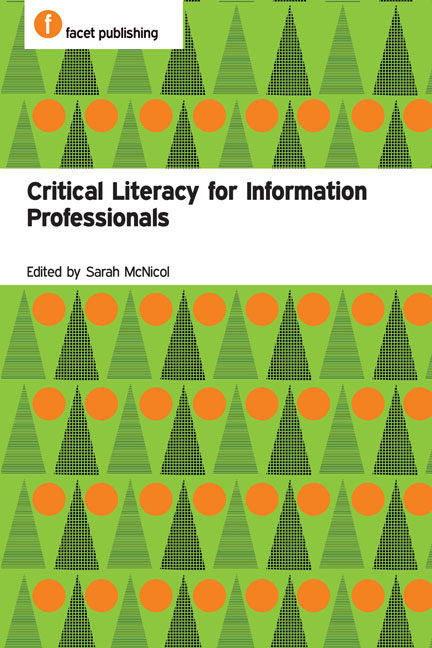Book contents
- Frontmatter
- Contents
- Contributors
- Introduction
- PART 1 THEORIES OF CRITICAL LITERACY
- PART 2 CRITICAL LITERACY IN PRACTICE
- 8 A picture is worth a thousand words: teaching media literacy
- 9 Curricular and extra-curricular opportunities to engage school students in critical literacy in England
- 10 New media and critical literacy in secondary schools
- 11 Critical literacy and academic honesty: a school librarian's role and contribution
- 12 Engaging undergraduate communications students in critical information literacy
- 13 Exploring pedagogical implications of students’ search mediation experiences through the lens of critical information literacy
- 14 Diffusing critical web literacy in a teacher-education setting: initial reflections and future planning
- Further information
- Index
8 - A picture is worth a thousand words: teaching media literacy
from PART 2 - CRITICAL LITERACY IN PRACTICE
Published online by Cambridge University Press: 08 June 2018
- Frontmatter
- Contents
- Contributors
- Introduction
- PART 1 THEORIES OF CRITICAL LITERACY
- PART 2 CRITICAL LITERACY IN PRACTICE
- 8 A picture is worth a thousand words: teaching media literacy
- 9 Curricular and extra-curricular opportunities to engage school students in critical literacy in England
- 10 New media and critical literacy in secondary schools
- 11 Critical literacy and academic honesty: a school librarian's role and contribution
- 12 Engaging undergraduate communications students in critical information literacy
- 13 Exploring pedagogical implications of students’ search mediation experiences through the lens of critical information literacy
- 14 Diffusing critical web literacy in a teacher-education setting: initial reflections and future planning
- Further information
- Index
Summary
Introduction
Morrell (2008, 6) argues that ‘no population requires critical literacy more than today's urban youth’ and, in particular, those young people who find themselves disadvantaged and with limited educational opportunities. Similarly, when considering the role of critical literacy in the school-to-prison pipeline among young Latino males, Garcia (2013, 8) claims that ‘The attainment of positive schooling experiences and empowering critical literacy skills for young Latino males can be one way to stop incarceration, decrease recidivism, and keep these youth on track to a successful future.’ She therefore considers that ‘it is imperative that the most disenfranchised youth, such as those who become a part of the school-to-prison pipeline or juvenile justice system, have access to quality, critical literacy educational experiences’.
A number of researchers have examined the role of critical literacy within the criminal justice system. In New York City, Vasudevan (2009) explored how adults and adolescents at the Alternative to Incarceration Program engaged in expressive multimodal literacy practices involving texting, social networking and photo/video sharing. In the UK, Sheridan (2006) proposed a Freirean approach to critical literacy for women prisoners within the Scottish Prison Service. In addition to achieving basic skills and meeting key performance targets in relation to prisoner literacy levels, she argues, such an approach could lead to the empowerment of women prisoners, beginning with personal empowerment and ending in collective empowerment.
For those who find themselves alienated, or even excluded, from the traditional school system, public libraries present a vital opportunity to develop ‘literacy for life’, not simply ‘literacy in the service of school’ (Lunsford, 2009, 396). In the UK for example, The Reading Agency (2008) produced a booklet of Ideas to Inspire People in Prisons and Young Offender Institutions. However, although both public libraries and, of course, prison libraries have often played an important role in supporting the development of basic literacy skills amongst offenders and those at risk of offending, this has usually been focused on what Morrell (2008, 3) describes as ‘a narrowly defined and conceived dominant literacy agenda’. The case study presented in this article attempts to address this imbalance by describing a public library-based programme focused on fostering critical literacy skills amongst at-risk teenagers.
- Type
- Chapter
- Information
- Critical Literacy for Information Professionals , pp. 93 - 104Publisher: FacetPrint publication year: 2016



